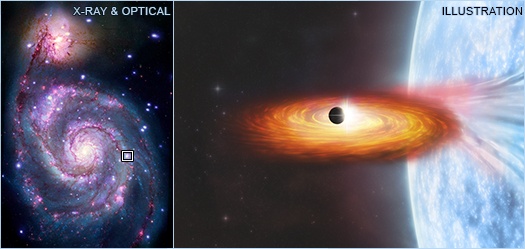Discovery of the first exoplanet candidate in X-ray binary M51-ULS-1 in the spiral galaxy Messier 51 (M51), also called the Whirlpool Galaxy using transit technique by observing dips in brightness at X-ray wavelengths (instead of optical wavelengths) is pathbreaking and a game changer because it overcomes the limitation of observation of dips in brightness at optical wavelengths and opens up the avenue for the search of exoplanets in external galaxies. Detection and characterisation of ດາວເຄາະ in external galaxies has significant implications for search for extra-terrestrial life.
“ແຕ່ທຸກຄົນຢູ່ໃສ?” Fermi had blurted out, way back in the summer of 1950, pondering why there is no evidence of any extra-terrestrial life (ET) out in the ຊ່ອງ despite high probability of its existence. Three quarters of the century past that famous line, still there is no evidence of any life anywhere outside the Earth, but the search continues and one of the key components of this search is the detection of ດາວເຄາະ outside the solar system and its characterisation for possible signatures of life.
ເກີນ 4300 exoplanets ໄດ້ຖືກຄົ້ນພົບໃນສອງສາມທົດສະວັດທີ່ຜ່ານມາເຊິ່ງອາດຈະມີຫຼືບໍ່ມີເງື່ອນໄຂທີ່ເຫມາະສົມເພື່ອສະຫນັບສະຫນູນຊີວິດ. ພວກມັນທັງໝົດໄດ້ຖືກພົບເຫັນຢູ່ໃນບ້ານຂອງພວກເຮົາ galaxy. ບໍ່ exoplanet was known to be discovered outside the Milky Way. In fact, there is no evidence to support the idea of presence of planetary system in any external galaxy.
Scientists have now reported ການຄົ້ນພົບ of a possible exoplanet candidate in an external galaxy for the first time. This extrasolar ດາວ is in the spiral galaxy Messier 51 (M51), also called the Whirlpool Galaxy, situated at a distance of about 28 million light years away from home galaxy ທາງຊ້າງເຜືອກ.
ໂດຍປົກກະຕິແລ້ວ, ກ ດາວ is detected by way of observing eclipse it produces when it transits in front of its ດາວ ໃນຂະນະທີ່ ວົງໂຄຈອນ around thus blocking the light emanating from the ດາວ (transit technique). This event is observed as temporary dimming of the star. Search for an exoplanet involves searching for dips in the light of a ດາວ. The other method of detection of ດາວເຄາະ is by radial velocity measurements. All exoplanets have been detected using these techniques in our home galaxy at relatively short intra-galactic distances in the range of 3000 light years.
However, searching for dips in the light at larger inter-galactic distances to detect exoplanets outside the Milky Way is an uphill task because an external galaxy occupies a small area in the sky and the high density of ດາວ does not allow study of an individual star in sufficient details to enable detection of signatures of a ດາວ. As a result, search at optical wavelength in an external galaxy was not feasible until now and no exoplanet outside our home galaxy could be discovered. The latest research is pathbreaking and a game changer because it seemingly overcomes this limitation by observing dips in brightness at X-ray wavelengths (instead of optical wavelengths), and opens up the avenue for the search of exoplanets in other galaxies.
X-ray binaries (XRBs) in the external galaxies are considered to be ideal for the search of exoplanets. These (i.e., XRBs) are a class of binary ດາວ made up of a normal star and a collapsed star like white dwarf or a ຫຼຸມດໍາ. ເມື່ອດວງດາວຢູ່ໃກ້ພໍ, ວັດສະດຸຈາກດາວປົກກະຕິຈະຖືກດຶງອອກຈາກດາວປົກກະຕິໄປສູ່ດາວທີ່ຫນາແຫນ້ນເນື່ອງຈາກແຮງໂນ້ມຖ່ວງ. ດັ່ງນັ້ນ, ວັດສະດຸທີ່ຕັ້ງຢູ່ໃກ້ກັບດາວທີ່ດົກໜາຈະກາຍເປັນຄວາມຮ້ອນສູງ ແລະເຫຼື້ອມເປັນແສງ X-rays ປະກົດວ່າເປັນແຫຼ່ງ X-ray ທີ່ສົດໃສ (XRSs).
With an idea to detect ດາວເຄາະ ວົງໂຄຈອນ X-ray binaries (XRBs), the research team searched for dips in the brightness of X-ray received from the bright X-ray binaries (XRBs) in three external galaxies, M51, M101, and M104.
ໃນທີ່ສຸດທີມງານໄດ້ສຸມໃສ່ X-ray binary M51-ULS-1 ເຊິ່ງເປັນແຫຼ່ງ X-ray ທີ່ສົດໃສທີ່ສຸດໃນກາລັກຊີ M51. ການຫຼຸດລົງຂອງຄວາມສະຫວ່າງຂອງ X-ray ທີ່ໄດ້ຮັບໂດຍ Chandra telescope ໄດ້ຖືກສັງເກດເຫັນ. ຂໍ້ມູນກ່ຽວກັບການຫຼຸດລົງໃນຄວາມສະຫວ່າງໄດ້ຖືກກວດກາສໍາລັບຄວາມເປັນໄປໄດ້ຕ່າງໆແລະພົບວ່າເຫມາະສໍາລັບການຖ່າຍທອດໂດຍດາວເຄາະ, ສ່ວນຫຼາຍອາດຈະເປັນຂະຫນາດຂອງດາວເສົາ.
This study is also novel for carrying out the search of exoplanets successfully for the first time at X-ray wavelength. On the broadest level, this landmark ການຄົ້ນພົບ of exoplanet outside our home galaxy expands the scope of search of exoplanets to other external galaxies, which has implications for the search of extra-terrestrial intelligent life.
***
ແຫລ່ງທີ່ມາ:
- Di Stefano, R., Berndtsson, J., Urquhart, R. et al. ຄວາມເປັນໄປໄດ້ຂອງດາວເຄາະໃນກາລັກຊີພາຍນອກທີ່ກວດພົບຜ່ານທາງຜ່ານ X-ray. ດາລາສາດທຳມະຊາດ (2021). DOI: https://doi.org/10.1038/s41550-021-01495-w. ມີຢູ່ໃນອອນໄລນ໌ https://chandra.harvard.edu/photo/2021/m51/m51_paper.pdf. ສະບັບພິມກ່ອນມີຢູ່ໃນ https://arxiv.org/pdf/2009.08987.pdf
- NASA. Chandra ເຫັນຫຼັກຖານສໍາລັບດາວທີ່ເປັນໄປໄດ້ໃນ Galaxy ອື່ນ. ມີໃຫ້ອອນໄລນ໌ຢູ່ https://chandra.harvard.edu/photo/2021/m51/
- NASA. ວິທະຍາສາດ – ວັດຖຸ – X-ray ສອງດາວ. ມີໃຫ້ອອນໄລນ໌ຢູ່ https://imagine.gsfc.nasa.gov/science/objects/binary_stars2.html
- Schwieterman E., Kiang N., et al 2018. Exoplanet Biosignatures: ການທົບທວນຄືນຂອງສັນຍານທີ່ກວດພົບໄດ້ຈາກໄລຍະໄກຂອງຊີວິດ. ໂຫລາສາດ Vol. 18, ສະບັບເລກທີ 6. Published Online on 1 Jun 2018. DOI: https://doi.org/10.1089/ast.2017.1729






































